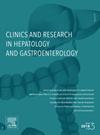美国肝细胞癌临终关怀模式的演变:一项25年的全国家庭和临终关怀利用差异分析。
IF 2.4
4区 医学
Q2 GASTROENTEROLOGY & HEPATOLOGY
Clinics and research in hepatology and gastroenterology
Pub Date : 2025-09-01
DOI:10.1016/j.clinre.2025.102686
引用次数: 0
摘要
背景和目的:肝细胞癌(HCC)仍然是全球和美国癌症相关死亡的主要原因之一。近几十年来,人们越来越重视在家庭或临终关怀机构中提供临终关怀,然而,关于这些模式如何因性别、种族/民族、地区和城市化而不同的当代详细见解仍然很少。本研究旨在描述HCC后代在25年内接受家庭或临终关怀的比例趋势,使用来自CDC WONDER数据库的数据。方法:通过ICD-10代码(C22.0)从疾病控制和预防中心的流行病学研究广泛在线数据(CDC WONDER)数据库中获取hcc相关死亡率数据,数据涵盖1999年至2024年。分析的重点是家庭或临终关怀死亡相对于hcc相关死亡总数的比例。调查了总体人口的趋势,并按种族/民族、性别、人口普查地区和城市化程度进行了分层。使用Joinpoint 5.30进行趋势分析,以确定时间格局的显著变化。结果:HCC患者在家中或临终关怀中死亡的总体比例在研究期间稳步上升,从1999年的约40.19%上升到最近一年的54.67%,总体总比例约为47.6%。在不同种族和族裔中,非西班牙裔白人从44.57%增加到58.04%,非西班牙裔黑人从27.38%增加到44.91%,西班牙裔从39.17%增加到51.38%。在家中或临终关怀中死亡的女性和男性都有上升趋势,女性从41.67%上升到54.48%,男性从39.64%上升到54.73%。地区差异很明显,南方一直报告的家庭或临终关怀死亡比例最高,从1999年的42.71%开始,到最近的数据达到58.38%,而东北的比例相对较低。从1999年到2020年,农村和城市地区都出现了类似的上升趋势,农村地区从41.16%上升到58.81%,城市地区从40.04%上升到59.86%。结论:总之,我们的研究强调了美国HCC患者临终关怀的明显进展和持续差异。尽管家庭/临终关怀的使用率显著增加,但种族/族裔群体和地理区域之间确实存在显著差异。为了实现健康公平,必须采取多种干预措施,消除获得医疗保健的障碍,增强姑息治疗管理的文化能力,并实施政策改革,以支持姑息治疗和改善疾病治疗同时进行。随着HCC患病率的不断上升,确保所有患者都能公平地获得高质量的临终关怀应该是医生、研究人员和政策制定者的首要任务。本文章由计算机程序翻译,如有差异,请以英文原文为准。
Evolving end-of-life care patterns for hepatocellular carcinoma in the United States: A 25-year national analysis of disparities in home and hospice utilization
Background and Aims
Hepatocellular carcinoma (HCC) remains one of the leading causes of cancer-related mortality worldwide and in the United States. In recent decades, there has been a growing emphasis on end-of-life care delivered in home or hospice settings, yet detailed contemporary insights into how these patterns differ by sex, race/ethnicity, region, and urbanization remain sparse. This study aimed to characterize the trends in the proportion of HCC descendants receiving home or hospice care over a 25-year period, using data derived from the CDC WONDER database.
Methods
Data for HCC-related mortality were obtained from the Centers for Disease Control and Prevention’s Wide-ranging Online Data for Epidemiologic Research (CDC WONDER) database by ICD-10 code (C22.0), covering the years from 1999 to 2024. The analysis focused on the proportion of home or hospice deaths relative to the total number of HCC-related deaths. Trends were examined for the overall population as well as stratified by race/ethnicity, sex, census region, and urbanization. Trend analysis was conducted using Joinpoint 5.30 to identify significant changes in the temporal patterns.
Results
The overall proportion of patients with HCC who died at home or in hospice increased steadily over the study period, rising from approximately 40.19% in 1999 to 54.67% in the most recent year, with an overall aggregate proportion around 47.6%. Among the different racial and ethnic groups, Non-Hispanic White decedents showed a notable increase from 44.57% to 58.04%, while Non-Hispanic Black decedents increased from 27.38% to 44.91%, and Hispanic decedents from 39.17% to 51.38%. Both female and male patients experienced rising trends in home or hospice deaths, with females increasing from 41.67% to 54.48% and males from 39.64% to 54.73%. Regional variations were evident, with the South consistently reporting the highest proportions of home or hospice deaths, starting at 42.71% in 1999 and reaching 58.38% in the latest data, while the Northeast exhibited comparatively lower rates. A similar upward trend between 1999 and 2020 was observed in both rural and urban areas, with rural settings increasing from 41.16% to 58.81% and urban settings from 40.04% to 59.86%.
Conclusion
In conclusion, our study highlights both obvious progress and persistent disparities in end-of-life care in HCC patients in the US. Significant disparities do exist between racial/ethnic groupings and geographical areas, despite a significant increase in home/hospice utilization. Multiple interventions which intend to remove barriers to healthcare access, enhance cultural competence palliative care administration, and apply policy reforms to support concurrent palliative and disease-modifying therapies will be necessary to achieve health equity. Ensuring that all patients have fair access to high-quality end-of-life care should be a top priority for physicians, researchers, and policymakers as the prevalence of HCC keeps increasing.
求助全文
通过发布文献求助,成功后即可免费获取论文全文。
去求助
来源期刊

Clinics and research in hepatology and gastroenterology
GASTROENTEROLOGY & HEPATOLOGY-
CiteScore
4.30
自引率
3.70%
发文量
198
审稿时长
42 days
期刊介绍:
Clinics and Research in Hepatology and Gastroenterology publishes high-quality original research papers in the field of hepatology and gastroenterology. The editors put the accent on rapid communication of new research and clinical developments and so called "hot topic" issues. Following a clear Editorial line, besides original articles and case reports, each issue features editorials, commentaries and reviews. The journal encourages research and discussion between all those involved in the specialty on an international level. All articles are peer reviewed by international experts, the articles in press are online and indexed in the international databases (Current Contents, Pubmed, Scopus, Science Direct).
Clinics and Research in Hepatology and Gastroenterology is a subscription journal (with optional open access), which allows you to publish your research without any cost to you (unless you proactively chose the open access option). Your article will be available to all researchers around the globe whose institution has a subscription to the journal.
 求助内容:
求助内容: 应助结果提醒方式:
应助结果提醒方式:


